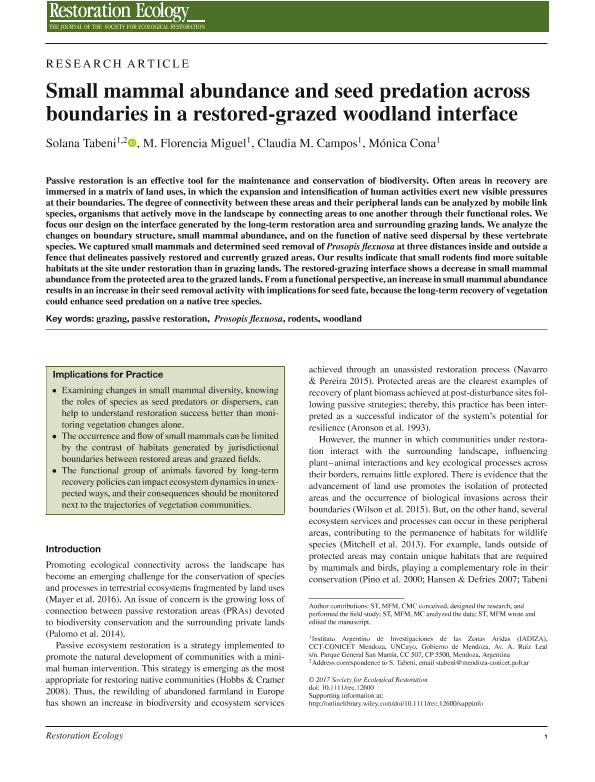Artículo
Small mammal abundance and seed predation across boundaries in a restored-grazed woodland interface
Fecha de publicación:
09/2017
Editorial:
Wiley Blackwell Publishing, Inc
Revista:
Restoration Ecology
ISSN:
1061-2971
Idioma:
Inglés
Tipo de recurso:
Artículo publicado
Clasificación temática:
Resumen
Passive restoration is an effective tool for the maintenance and conservation of biodiversity. Often areas in recovery are immersed in a matrix of land uses, in which the expansion and intensification of human activities exert new visible pressures at their boundaries. The degree of connectivity between these areas and their peripheral lands can be analyzed by mobile link species, organisms that actively move in the landscape by connecting areas to one another through their functional roles. We focus our design on the interface generated by the long‐term restoration area and surrounding grazing lands. We analyze the changes on boundary structure, small mammal abundance, and on the function of native seed dispersal by these vertebrate species. We captured small mammals and determined seed removal of Prosopis flexuosa at three distances inside and outside a fence that delineates passively restored and currently grazed areas. Our results indicate that small rodents find more suitable habitats at the site under restoration than in grazing lands. The restored‐grazing interface shows a decrease in small mammal abundance from the protected area to the grazed lands. From a functional perspective, an increase in small mammal abundance results in an increase in their seed removal activity with implications for seed fate, because the long‐term recovery of vegetation could enhance seed predation on a native tree species.
Palabras clave:
Grazing
,
Passive Restoration
,
Prosopis Flexuosa
,
Rodents
Archivos asociados
Licencia
Identificadores
Colecciones
Articulos(IADIZA)
Articulos de INST. ARG DE INVEST. DE LAS ZONAS ARIDAS
Articulos de INST. ARG DE INVEST. DE LAS ZONAS ARIDAS
Citación
Tabeni, Maria Solana; Miguel, María Florencia; Campos, Claudia Monica; Cona, Monica Ines; Small mammal abundance and seed predation across boundaries in a restored-grazed woodland interface; Wiley Blackwell Publishing, Inc; Restoration Ecology; 9-2017; 1-9
Compartir
Altmétricas




